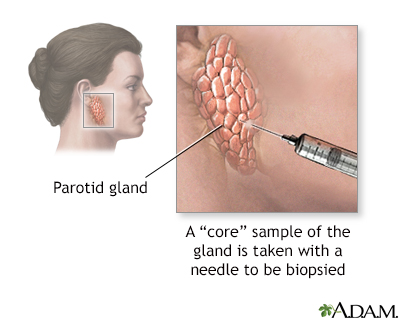Salivary gland biopsy
Biopsy - salivary gland
Salivary gland biopsy is the removal of cells or a piece of tissue from a salivary gland for exam.
Images

I Would Like to Learn About:
How the Test is Performed
You have several pairs of salivary glands that drain into your mouth:
- A major pair in front of the ears (parotid glands)
- Another major pair beneath your jaw (submandibular glands)
- Two major pairs on the floor of the mouth (sublingual glands)
- Hundreds to thousands of minor salivary glands in the lips, cheeks, and tongue
One type of salivary gland biopsy is a needle biopsy.
- The skin or mucous membrane over the gland is cleaned with rubbing alcohol.
- A local pain-killing medicine (anesthetic) may be injected, and a needle is inserted into the gland.
- A piece of tissue or cells are removed and placed on slides.
- The samples are sent to the lab to be examined.
A biopsy can also be done to:
- Determine the type of tumor in a salivary gland lump.
- Determine if the gland and tumor need to be removed.
An open surgical biopsy of the minor salivary glands in the lips or the parotid gland can also be performed to diagnose diseases such as Sjögren syndrome.
How to Prepare for the Test
There is no special preparation for a needle biopsy. However, you may be asked not to drink or eat anything for a few hours before the test.
For surgical removal of a tumor, preparation is the same as for any major surgery. You will not be able to eat anything for 6 to 8 hours before the surgery.
How the Test will Feel
With a needle biopsy, you may feel some stinging or burning if a local numbing medicine is injected.
You may feel pressure or mild discomfort when the needle is inserted. This should only last for 1 or 2 minutes.
The area may feel tender or be bruised for a few days after the biopsy.
The biopsy for Sjögren syndrome requires an injection of the anesthetic in the lip or in the front of the ear. You will have stitches where the tissue sample was removed.
Why the Test is Performed
This test is done to find the cause of abnormal lumps or growths of the salivary glands. It is also done to diagnose Sjögren syndrome.
Normal Results
The salivary gland tissue is normal.
What Abnormal Results Mean
Abnormal results may indicate:
- Salivary gland tumors or infection
- Sjogren syndrome or other forms of gland inflammation
Risks
Risks from this procedure include:
- Allergic reaction to the anesthetic
- Bleeding
- Infection
- Injury to the facial or trigeminal nerve (rare)
- Numbness of the lip
Related Information
Salivary gland tumorsReferences
Miloro M, Kolokythas A. Diagnosis and management of salivary gland disorders. In: Hupp JR, Ellis E, Tucker MR, eds. Contemporary Oral and Maxillofacial Surgery. 7th ed. Philadelphia, PA: Elsevier; 2019:chap 21.
Orlowski HLP, Miller-Thomas M. Diagnostic imaging and fine-needle aspiration of the salivary glands. In: Flint PW, Francis HW, Haughey BH, et al, eds. Cummings Otolaryngology: Head and Neck Surgery. 7th ed. Philadelphia, PA: Elsevier; 2021:chap 82.
BACK TO TOPReview Date: 3/1/2023
Reviewed By: Josef Shargorodsky, MD, MPH, Johns Hopkins University School of Medicine, Baltimore, MD. Also reviewed by David C. Dugdale, MD, Medical Director, Brenda Conaway, Editorial Director, and the A.D.A.M. Editorial team.

Health Content Provider
06/01/2025
|
A.D.A.M., Inc. is accredited by URAC, for Health Content Provider (www.urac.org). URAC's accreditation program is an independent audit to verify that A.D.A.M. follows rigorous standards of quality and accountability. A.D.A.M. is among the first to achieve this important distinction for online health information and services. Learn more about A.D.A.M.'s editorial policy, editorial process and privacy policy. A.D.A.M. is also a founding member of Hi-Ethics. This site complied with the HONcode standard for trustworthy health information from 1995 to 2022, after which HON (Health On the Net, a not-for-profit organization that promoted transparent and reliable health information online) was discontinued. |
The information provided herein should not be used during any medical emergency or for the diagnosis or treatment of any medical condition. A licensed medical professional should be consulted for diagnosis and treatment of any and all medical conditions. Links to other sites are provided for information only -- they do not constitute endorsements of those other sites. © 1997- 2025 A.D.A.M., a business unit of Ebix, Inc. Any duplication or distribution of the information contained herein is strictly prohibited.
